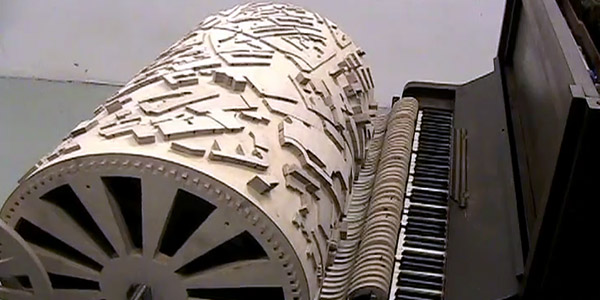Digital or analog, the essence of recording and production is the act of representing. One thing becomes another; one medium stores information about another. That representation can also be physical, tangible, and visible. In a sculptural pianola, Akko Goldenbeld turns the Dutch city of Eindhoven into a pianola roll, so that the landscape of buildings and streets acts as a physical musical score. I think it raises some questions about whether translating the one into the other obscures the experience of a city rather than clarifies it, but that would discount the act of watching it: with the visual connected to the sound, one begins to see the topography of the resulting music.
From the description on the video:
The tall buildings in the city centre have a heavy touch; the low-rise villas to the South create considerably gentler sounds. Akko Goldenbeld has a very personal way of looking at, or rather listening to the city.
He has created a scale model of Eindhoven and assigned it the role of sound recorder; the buildings create a score. Placed on a revolving wooden cylinder the buildings set little hammers in motion that play the keys of a piano. And turning and turning, the city makes its voice heard: from loud to soft, long to short, high-pitched to low, traslating the urban developers’s three-dimensional reality into an aural experience. Stadsmuziek (City Music) makes you tune in to the ensemble-playing that is environemental planning.
Via a terrific blog dedicated to data visualization (and, here, sonification) and their relation to design, Infosthetics. (Say that three times fast. Infosthetics sells aesthetic sensibilities by the seashore… Yesth, indeed. I’m glad this is a blog and not radio. It’s eight minutes past the hour. This is CDM.)
